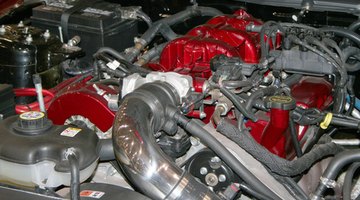Appealing to the luxury car market, the Range Rover P38 combines best-of-class off-road ability with high-level comfort specifications. It launched in 1994, and production ran until 2002, when the Mk III replaced it. However, a number of faults commonly associated with the P38 are prevalent both mechanically and electrically. Fortunately, enthusiasts and mechanics alike have documented these faults well.
Electrical Faults
The security system on a Range Rover P38 contains an engine immobiliser and lockout system on which the SUV's most frequent electrical problems have centred. Remote control failures of the system have occurred often, but a performing a last-resort fix using key sequence turning in the driver's door can help you override the system failure. (The key sequence appears on the security card that came with the car.) Dead batteries, an additional issue with the security system, have often resulted from radio/static wave interference, which continually turns on the body electrical control module (BeCM) and drains the battery.
- The security system on a Range Rover P38 contains an engine immobiliser and lockout system on which the SUV's most frequent electrical problems have centred.
- Dead batteries, an additional issue with the security system, have often resulted from radio/static wave interference, which continually turns on the body electrical control module (BeCM) and drains the battery.
Mechanical Faults

The P38's transmission can sometimes stick in Park, which occurs because a brake light fuse has blown that automatically stops you from driving without your brake lights working. Valve problems have occurred frequently in the P38; valves often become sticky due to excessive carbon build-up or even inaccurate valve tolerance measurements in the valve guides. Vibration in the steering wheel, another mechanical issue, often occurs when the SUV travels at high speeds over off0road terrain. Adjusting the steering box provides an easy solution to the mechanical shudder.
- The P38's transmission can sometimes stick in Park, which occurs because a brake light fuse has blown that automatically stops you from driving without your brake lights working.
- Vibration in the steering wheel, another mechanical issue, often occurs when the SUV travels at high speeds over off0road terrain.
Physical Faults

The P38 Range Rover is prone to fluid leaks of all types. Common faults include unreliable oil pan seals, oil leaks from the front and rear pinion seals, the O-ring seal on the oil pressure switch and the axle seals. Water leaks in the foot well, another common occurrence, may result from a fault in the air-conditioning system---usually the drain from the evaporator. Another prevalent fault occurs with the air intake filter, which decays over time and moves out of position, requiring regular checks for replacement. Finally, the windshield washer system fails over time due to heat exposure on the washer jets causing brittleness.
- The P38 Range Rover is prone to fluid leaks of all types.
- Another prevalent fault occurs with the air intake filter, which decays over time and moves out of position, requiring regular checks for replacement.
